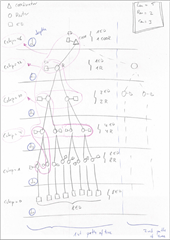Hi everyone,
I need to know how many routers can I have in a Zigbee tree topology based on ZStack 1.4.3.
I am working with a coordinator and several routers, without ED. By default in the ZStack Lm (max depth) is 5, Cm (max children) is 20 and Rm (max Routers), so that means there are a max of 31101 addressable nodes (Coor + Routers + ED), using the Cskip formula. If depth is 5, a max of nodes can be addressed "vertically", from 1 to 5, in terms of topology. But my concern is how many routers can I have "vertically and horitzontally" in this topology, since children nodes can be Routers and children Routers.
So, is there any equation to calculate the max number of router + children routers using the Cskip params (Lm, Rm and Cm)? If, not is there an alternative?
Thanks.
Joaquim.





